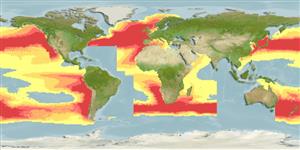Actinopterygii (Straalvinnigen) >
Perciformes (Perch-likes) >
Tetragonuridae (Squaretails)
Etymology: Tetragonurus: Greek, tetra = four + Greek, gonia = angle + Greek, oura = tail (Ref. 45335); cuvieri: Named after G.C.L.D. Cuvier 1769-1832, a founder of modern ichthyology (Ref. 6885). More on author: Risso.
Omgeving / Klimaat / Range
Ecologie
; marien bathypelagisch; oceanodroom (Ref. 51243); diepteverspreiding 1 - 800 m (Ref. 10823). Deep-water, preferred ?
Eastern Pacific: Aleutian Islands, Alaska to Baja California, Mexico; Chile (Ref. 9068). Western Pacific: Japan (Ref. 559), New Zealand and Australia (Ref. 6885). Western Indian Ocean: Natal, South Africa (Ref. 4415). Atlantic Ocean, including the Mediterranean (Ref. 4415).
Size / Gewicht / Leeftijd
Maturity: Lm ? range ? - ? cm
Max length : 70.0 cm TL mannelijk/geslacht niet bekend; (Ref. 4415)
Dorsale stekels (totaal): 15 - 21; Dorsale zachte stralen (totaal): 12-15; Anale stekels 1; Anale zachte stralen: 11 - 13; Wervels: 52. Pectorals and pelvic fins small (Ref. 6885). Dark brown, paler at base of tail and on head, otherwise almost uniform throughout (Ref. 6885).
Oceanic, usually near surface; possibly near bottom. Perhaps occurs in schools. Young usually among jellyfishes or inside large salps. Feeds on jellyfishes and salps (Ref. 2850), also other soft-bodied coelenterates, ctenophores, as well as plankton. There are conflicting reports that the flesh of this species is poisonous (Ref. 11149).
Life cycle and mating behavior
Geslachtsrijpheid | Voortplanting | Kuitschieten | Eieren | Fecundity | Larven
Haedrich, R.L., 1986. Tetragonuridae. p. 851. In M.M. Smith and P.C. Heemstra (eds.) Smiths' sea fishes. Springer-Verlag, Berlin. (Ref. 4415)
Status op de Rode Lijst van het IUCN (Ref. 115185)
CITES (Ref. 94142)
Not Evaluated
Gevaarlijk voor mensen
Reports of ciguatera poisoning (Ref. 4690)
Gebruik door de mens
Meer informatie
ReferentiesAquacultuurAquacultuurprofielKweeklijnenGeneticaAlleelfrequentiesErfelijkheidZiektenVerwerkingMass conversion
Tools
Speciale rapporten
Download XML
Internet-bronnen
